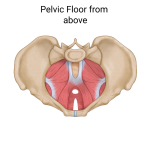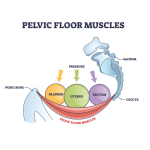Downloaded from www.mymenopausecentre.com
Direct URL: https://www.mymenopausecentre.com/blog/how-to-strengthen-your-pelvic-floor-and-why-you-should/
How to strengthen your pelvic floor (and why you should)
Found yourself accidentally peeing during a star jump or sneeze? Fret not – it happens to so many midlife women courtesy of weak pelvic floor muscles. Thankfully, it’s easy to get them back in shape as physiotherapist Katie Knapton, from Physiofastonline, shows us here.

It is important to start by making it clear that every woman needs to do pelvic floor exercises throughout their lives to ensure they have good bladder control. More about how to do them later!
What is the pelvic floor?
The pelvic floor muscles attach directly at the front of our pelvis (our pubis) and form a sling of muscle that attaches to our tailbone at the bottom of our spines. They support the organs of the bladder, uterus and bowel which is one of their main functions.


Like all muscles the pelvic floor muscles need to be exercised and the term “use it or lose it” couldn’t be more relevant here.
At certain times in our lives the pelvic floor muscles may become weak for a number of reasons including childbirth and pregnancy; decreased muscle tone as we age; long term straining from constipation; a chronic cough; obesity; underuse; and of course – menopause.
Incontinence explained
It’s probably unsurprising that 1 in 3 women suffer with incontinence – a term that refers to any involuntary loss of urine, wind or faeces. There are obviously different levels of severity but the earlier it is recognised and treated the easier and quicker things can be resolved. There are different kinds and often people have a mix of both.
Urinary stress incontinence is the most common type and usually happens with physical movement or activity — such as coughing, laughing, sneezing, running or heavy lifting — which puts pressure (stress) on your bladder, causing you to leak urine. This is usually caused by weakness in the pelvic floor and that it has the best response to pelvic floor exercises.
Urinary urge incontinence is when you have a sudden, intense urge to urinate followed by an involuntary loss of urine and you may need to urinate often, including throughout the night. If no underlying medical cause this can often be helped by bladder retraining.
Listen to your body
It’s really important to remember that it is not normal to leak at any age and a “sneeze-wee” is not to be accepted or ignored and needs to be addressed to further avoid deterioration – and it is never too late to start.
The good news is that for the vast majority of women (at least 74%) incontinence can be improved and/or fixed by doing regular pelvic floor exercises.
5 tips to try
- Initiate the muscles by tightening and lifting your back passage as if you are holding in wind (a fart!). Check you are breathing normally when attempting these exercises, avoid any bearing down. It is important that the right muscle contraction is initiated.
- Remember #wewon’tpeewitha10103*- 10 short, fast contractions, 10 long contractions (building up to hold for 10) x3 daily.
- Get into the habit of doing them every time you brush your teeth, when you are queuing or set a timer on your phone or download an app (Squeezy app is a very popular one)
- Do not expect miracles – it will take time to make a difference but sometimes people notice a difference quickly. You need to keep going. But the sooner you start, the quicker you are likely to get results.
- Some women like to use gadgets to help them and there are three different types, training in nature, weighted exercise balls and stimulators which make the muscles contract. These may be useful but there is no real shortcut – you have to be prepared to find the time to train the muscles!
*Elaine Miller Women’s Health Physio
For more tips on avoiding midlife leaks check out this video
To get a handle on general bladder problems head here
Katie Knapton can be found here
Join the pause. community
We’ve created pause. as a space for women to come together and share stories about their menopause experience, ask questions, and to find support and inspiration. We'll also share the latest news and updates on the menopause from our experts.
Want to be the first to hear our latest news? Join our pause. community today.
Share your email to receive the latest news, updates and information on new products and treatments from My Menopause Centre and our pause. community. You can unsubscribe at any time.
We're committed to protecting and respecting your privacy - see our Privacy Policy and Terms and Conditions

Book a consultation
Whether you want to discuss your symptoms, create a treatment plan that's right for you, understand some test results or have a check-up, the highly experienced doctors and nurses in our menopause clinic are here to help you.
Book nowContact My Menopause Centre
- General enquiries: hello@mymenopausecentre.com
- Book appointments online: Log into your account and go to 'My appointments'
- Book appointments by phone: 0333 444 1067
- Website: https://www.mymenopausecentre.com



















We’d love to hear from you
Please ensure you’re logged in to leave a comment. Not got an account – registration is quick and easy! All comments are moderated prior to being posted on the website and are subject to our Acceptable Use Policy.
Comments